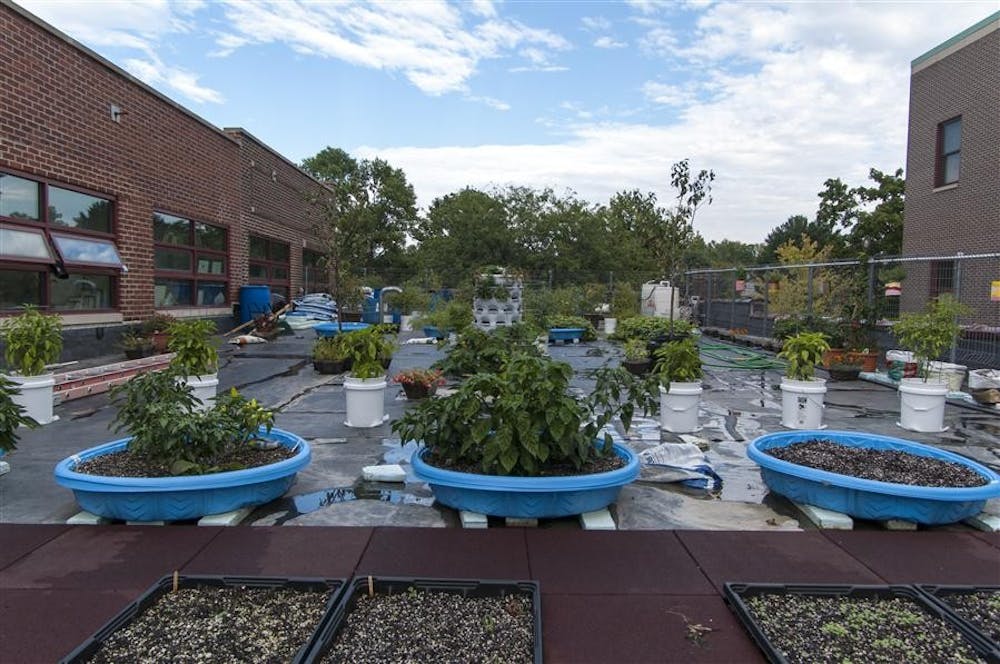The buildings along South Washington Street are constructed of red bricks and white doors. The windows reflect parked vehicles. Brick roofs line the tops of downtown business, except one.
The roof of Middle Way House sprouts with rows of produce.
Plants in handmade pots hang from the chain-link fence as hoses wind through a maze of fresh veggies.
Andrea Jobe, rooftop garden coordinator at Middle Way House, said the garden produces organic, edible vegetables, including squash, peppers, onions, watermelon, tomatoes and more.
“We have a lot of edibles but also plants to attract the necessary insects and bees,” Jobe said. “To my knowledge, the garden is Bloomington’s first and largest edible rooftop garden.”
The garden promotes environmental and sustainable planting with recycling and water conservation techniques. Vegetables are planted inside plastic kiddie pools saved from a trip to a landfill. Other plants are housed inside old feed bags.
Funding from the garden comes from local community donations and grants. The garden committee plans to construct a business plan for the produce, Jobe said.
By contracting with restaurants and cafes, Jobe said she hopes to produce enough food to prove the garden’s future capabilities. Foodworks is a small cafe and catering service existing as a part of Middle Way House.
“Many of the cafe’s employees are, or once were, residents of Middle Way,” said Tess Kuntz, the Middle Way House lead education intern. “The cafe is one of the reasons the rooftop garden project began. We are hoping to sell to and provide for them.”
Another sustainable improvement unique to Middle Way House utilizes open-top barrels to collect water. Eric Wainwright, the main maintenance staff member for Middle Way House, said Middle Way uses three different water sources, all contributing to the watering of the garden. Although Jobe and Wainwright struggle daily with the drought, they said their garden is probably the most prepared in Bloomington to survive the lack of water.
“The open-top barrels collect rainwater and the condensation created by the air conditioning systems set up around the building,” Wainwright said. “There is a ground water pump in the basement that is brought to the roof, which also is a main water source for the garden.”
Wainwright hopes to attain engineering grants and donations to introduce a new solar plan to solve any landscape and water issues. With the weekend’s storm, the barrels are overflowing with excess rainwater.
“We had to elevate plants because of the storm,” Jobe said. “We used packaging waste, which we saved again from the landfill, for elevation.”
Beyond generating more than 60 pounds of organic crops, the garden is used to educate Middle Way residents and community members about nutrition and farming.
Kuntz said the goal this year was to grow a minimum of 75 pounds of food.
“We definitely will surpass that,” Kuntz said. “And with the drought, which is really good, we always had water.”
The food created during the summer was recently gathered by children living at Middle Way House for a homemade pizza party. The garden teaches the children, most of whom are elementary school age, about plants, water and sustainability.
“I was very pleased with the pizza party because the kids actually picked and ate many of the vegetables that were grown,” Kuntz said. “I thought they wouldn’t want to eat veggies, but they picked everything.”
Everything inside the rooftop garden was new this summer. Jobe said they made substantial progress on the project in a short time. Many innovations to the garden have yet to be added.
As a long-term goal, Jobe and the garden managers expect to establish more vertically growing plants. They also want to add more designs, art and color so everyone in town can enjoy the garden.
In the winter, Jobe and Wainwright plan to use season extension techniques to protect the garden’s supplies. With the help of donations and mentors, they hope to dispel the effects of frost and use low tunnels to lengthen the garden’s lifespan.
“We still have some learning to do ourselves,” Jobe said. “We have to look towards major cities for inspiration. Right now, we are the only urban growing rooftop in Bloomington, the local pioneers of urban gardening.”
Middle Way House rooftop garden thrives despite drought

Get stories like this in your inbox
Subscribe





